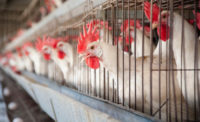Study Explores Temporal Implications of Campylobacter Prevalence of Poultry, Human Outbreaks

Credit: Pexels via Pixabay
A recent study published in the International Journal of Food Microbiology explores the relationship between the incidence of campylobacteriosis and the prevalence of Campylobacter in poultry broilers. The study suggests that there is a two-week time lag between human cases and broiler prevalence, indicating that it is possible for cases of campylobacterosis to be caused by transmission of the pathogen through poultry meat.
Researchers conducted an analysis of weekly, biweekly, and monthly data of campylobacteriosis in humans and Campylobacter prevalence in broilers at slaughter in Sweden between 2009 and 2019. In Sweden, where the study was conducted, the prevalence of Campylobacter in broilers at slaughter has ranged from 5 to 15 percent, historically, with the highest rates of prevalence occurring in late summer and the lowest rates occurring in the winter. While the data showed seasonal patterns and variations, one model revealed a close overlap in terms of timing and the proportional change of peaks from normal yearly levels.
The study notes, however, that there is no simple relationship between prevalence in chickens bred for meat and in patients. Additional factors also need to be evaluated to understand the transmission routes and epidemiology of campylobacteriosis. The analyses were also unable to link increased broiler prevalence with a rise in campylobacteriosis cases in humans.
The study also states that its findings are in accordance with factors such as the incubation period for Campylobacter, as well as the time between sampling for broiler prevalence at slaughter and the onset of illness.
Looking for a reprint of this article?
From high-res PDFs to custom plaques, order your copy today!








